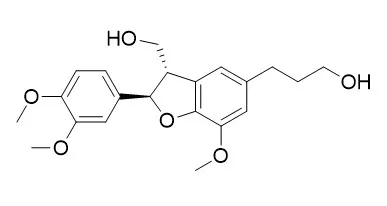| In vivo: |
| Phytomedicine, 1995, 2(1):17-22. | | In vivo wound healing activity of Dragon's Blood (Croton spp.), a traditional South American drug, and its constituents[Reference: WebLink] |
METHODS AND RESULTS:
The wound healing activity of dragon'sblood (Croton spp.), in Spanish ‚sangre de drago‛ or ‚sangre de grado‛, a traditional South American drug, and some of its constituents, including the alkaloid taspine (1), the dihydrobenzufuran lignan 3′,4-O-dimethylcedrusin (3,4-O-dimethylcedrusin,2) and proantho-cyanidins, was evaluated in vivo on rats, and compared with the wound healing actitivy of synthetic proanthocyanidins. The beneficial effect of dragon's blood on wound healing was confirmed. Dragon's blood stimulated contraction of the wound, formation of a crust, formation of new collagen, and regeneration of the epithelial layer.
3′,4-O-Dimethylcedrusin also improved wound healing in vivo by stimulating the formation of fibroblasts and collagen, but crude dragon's blood was more effective.
CONCLUSIONS:
This was due to the proanthocyanidins, present in dragon's blood, which stimulate contraction of the wound and precipitate with proteins forming a dark crust covering the wound, but which delay wound repair by a decreased formation of new fibroblasts. |
|






 Cell. 2018 Jan 11;172(1-2):249-261.e12. doi: 10.1016/j.cell.2017.12.019.IF=36.216(2019)
Cell. 2018 Jan 11;172(1-2):249-261.e12. doi: 10.1016/j.cell.2017.12.019.IF=36.216(2019) Cell Metab. 2020 Mar 3;31(3):534-548.e5. doi: 10.1016/j.cmet.2020.01.002.IF=22.415(2019)
Cell Metab. 2020 Mar 3;31(3):534-548.e5. doi: 10.1016/j.cmet.2020.01.002.IF=22.415(2019) Mol Cell. 2017 Nov 16;68(4):673-685.e6. doi: 10.1016/j.molcel.2017.10.022.IF=14.548(2019)
Mol Cell. 2017 Nov 16;68(4):673-685.e6. doi: 10.1016/j.molcel.2017.10.022.IF=14.548(2019)